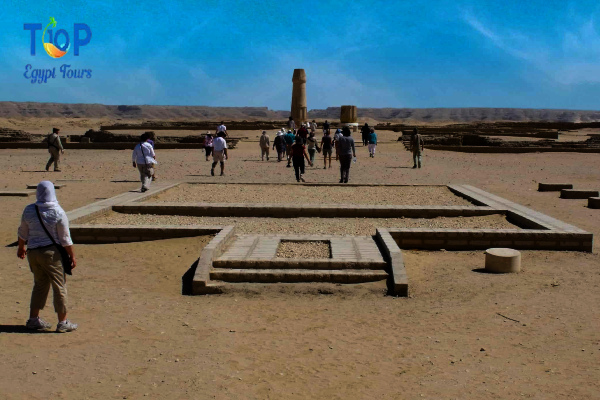Ancient Ruins of Akhenaten’s Capital City, Located in the heart of the Egyptian desert, there is a hidden gem that is often overlooked by tourists. Amarna, also known as Akhenaten, was the capital of ancient Egypt during the reign of Pharaoh Akhenaten. Although abandoned after his death and largely forgotten for centuries, Ancient Ruins of Akhenaten’s Capital City has recently gained renewed interest among archaeologists and history buffs alike.
The story goes back to King Amenhotep IV (ca. 1352 – 1336 BC), in what is often described as a “religious revolution”, which mainly targeted the god Amun, whose main center of worship was in Thebes (now Luxor). During his reign, he became Aton. The only god who was worshiped, this coincided with the king changing his name to Akhenaten, and this was followed by the establishment of a new capital in Middle Egypt (currently in Minya Governorate) called Akhet Aten (Aten Horizon), and Akhet Aten. On the eastern tenth of the Nile River, where there are distinctive hills, carved into representations of statesmen, are divided into two groups: north and south of the valley, leading to the site of the royal cemetery.
Akhet Aten has a clear design: the Royal Road extends from the north to the south of the city, and on both sides of it are the most important royal and administrative properties. To the south of the Royal Road is the Royal Palace, then the Great Temple of Aten.
Akhenaten’s employees liked to appear in luxurious homes, to enjoy the gardens, and the homes and workshops of artists were revealed. After Akhenaten’s death, the city was abandoned and destroyed.
There are 25 carved tombs in the eastern mountain area representing statesmen and priests. They are large modern engraved tombs with religious themes representing the art of Amarna and the religion of Akhenaten, and views of the religious buildings in the city such as the large and small, the house of the king, Akhenaten, Nefertiti and their daughters, in addition to the royal cemetery, whose design resembles the state tombs in the Valley of the Kings. It is located inside the mountain, 15 km east of the archaeological site.
And after the important monuments in Amarna, including:
1.The Great Temple of the Aten:
Begin your exploration with the Great Temple of the Aten, the spiritual heart of Amarna. Marvel at the grandeur of the colossal statues of Akhenaten and his queen, Nefertiti, as they reach towards the heavens. The intricate carvings and hieroglyphs on the temple walls narrate the religious fervor and artistic brilliance of the Amarna period.
2. Royal Palaces:
Delve into the ruins of the Royal Palaces, where the daily life of the royal family unfolded. The labyrinthine structures reveal the innovative architectural designs of the time, showcasing Akhenaten’s departure from traditional Egyptian art and construction.
3. The Tombs of Amarna:
Explore the hidden tombs of Amarna, where the nobility and officials of Akhenaten’s court were laid to rest. The vivid wall paintings and hieroglyphics provide a glimpse into the beliefs and rituals surrounding death during the Amarna period.
4. The Boundary Stelae:
Discover the Boundary Stelae, inscriptions that marked the perimeters of Akhenaten’s new city. These ancient stones tell tales of the pharaoh’s devotion to the sun god and his quest to establish a utopian society dedicated to Aten worship.
5. The Small Aten Temple:
Unearth the mysteries of the Small Aten Temple, a more intimate sanctuary dedicated to the worship of Aten. The tranquil surroundings invite reflection, allowing visitors to connect with the spiritual essence that once permeated this sacred space.
6. Nefertiti’s Workshop:
Visit Nefertiti’s Workshop, a site believed to be associated with the famous queen. Explore the remnants of workshops and gain insights into the artistic processes of creating the iconic bust of Queen Nefertiti, now housed in the Neues Museum, Berlin.
As you wrap up your journey through the hidden gems of Amarna, take a moment to reflect on the significance of this ancient city. The ruins of Akhenaten’s capital offer a captivating glimpse into a period of radical change and spiritual fervor, making it a must-visit destination for travelers seeking a deeper understanding of Egypt’s rich history. Top Ten Egypt Tours invites you to embark on this extraordinary adventure, where every stone has a story to tell and every carving whispers the secrets of a bygone era.
Experience the wonders of Egypt with our exclusive tours Click Here!



Comment (0)